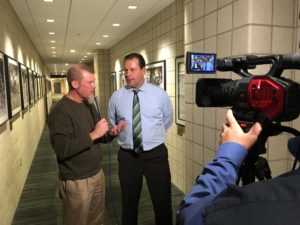Brad Berry played in the Dallas Stars organization
for a number of years, including a couple of seasons in Minnesota,
several with the top farm club in Kalamazoo, and the team’s inaugural
season in Dallas. The former defenseman has since returned to his alma
mater, the University of North Dakota, as the head coach. He won a
national championship two years ago in his first season as the man in
charge and has his group off to a 3-0-1 start this season.
We interviewed Berry, who bore some stitches above his
right eye thanks to a wayward practice puck, after his team had just
finished sweeping a pair of games from the St. Lawrence Saints. Before
the Saturday game, the program honored the 1986-87 team that won a
national title. A number of the players from that squad had returned to
campus to enjoy a reunion, including a pair who also won a Stanley Cup
with the Stars: Ed Belfour and Tony Hrkac. That North Dakota team, in
fact, became known as “The Hrkac Circus,” as they set scoring records
and became the first college hockey team to record 40 wins in a season.

Coach Berry commented on what it meant to have that team
return to the ice, both for him and his players. I also asked him about
the hockey experience at the Ralph Englestad Arena. It was my first time
to visit the facility and it is a remarkable place to watch a game.
Impressive physical features include marble floors and padded seats, and
they have a row of suites and a couple of clubs with a view of the
action. The crowd is into it, with chants and gestures and a band. In
the interview, Berry compared it to a college football atmosphere and I
agree with him. At the second intermission, the band even plays as they
march around the concourse. A hockey fan might want to put a North
Dakota game on his or her bucket list.
Rush Olson has spent two decades directing creative efforts for sports teams and broadcasters. He currently creates ad campaigns, television programs, and related creative projects for sports entities through Rush Olson Creative & Sports, Mint Farm Films, and FourNine Productions.